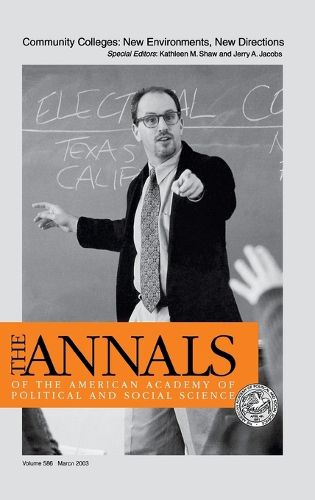Readings Newsletter
Become a Readings Member to make your shopping experience even easier.
Sign in or sign up for free!
You’re not far away from qualifying for FREE standard shipping within Australia
You’ve qualified for FREE standard shipping within Australia
The cart is loading…






This title is printed to order. This book may have been self-published. If so, we cannot guarantee the quality of the content. In the main most books will have gone through the editing process however some may not. We therefore suggest that you be aware of this before ordering this book. If in doubt check either the author or publisher’s details as we are unable to accept any returns unless they are faulty. Please contact us if you have any questions.
Community colleges have experienced a dramatic shift in focus and direction over the past 25 years. The impact of federal policy that emphasizes employment over education and the increased pressure for community colleges to meet the needs of local industries has led experts to ask whether or not contemporary community colleges are best serving their students.
As a bridge between public K-12 schools and higher education, community colleges were designed as a gateway for groups of students who would otherwise be excluded from higher education, most notably poorer and minority students. Ideally, this education sector should be a democratizing force in American society. Yet community colleges continue to struggle with their mission, and a variety of factors make it increasingly difficult to meet it. The articles in this special issue of the ANNALS examine the role of community colleges and how they respond to an emerging set of challenges. Three basic themes are threaded throughout the journal: recent changes in federal policy and how it affects community colleges; societal factors that have contributed to the movement of community colleges away from their traditional academic mission; and how well specific community college practices serve the academic and employment needs of their students. All of the authors agree that community colleges are, overall, increasingly responsive to the industry and business sector rather than to the students enrolled in their courses. Scholars, community college leaders, and policymakers will find these insights a valuable resource as the effort to define and meet the goals of community colleges continue.
$9.00 standard shipping within Australia
FREE standard shipping within Australia for orders over $100.00
Express & International shipping calculated at checkout
This title is printed to order. This book may have been self-published. If so, we cannot guarantee the quality of the content. In the main most books will have gone through the editing process however some may not. We therefore suggest that you be aware of this before ordering this book. If in doubt check either the author or publisher’s details as we are unable to accept any returns unless they are faulty. Please contact us if you have any questions.
Community colleges have experienced a dramatic shift in focus and direction over the past 25 years. The impact of federal policy that emphasizes employment over education and the increased pressure for community colleges to meet the needs of local industries has led experts to ask whether or not contemporary community colleges are best serving their students.
As a bridge between public K-12 schools and higher education, community colleges were designed as a gateway for groups of students who would otherwise be excluded from higher education, most notably poorer and minority students. Ideally, this education sector should be a democratizing force in American society. Yet community colleges continue to struggle with their mission, and a variety of factors make it increasingly difficult to meet it. The articles in this special issue of the ANNALS examine the role of community colleges and how they respond to an emerging set of challenges. Three basic themes are threaded throughout the journal: recent changes in federal policy and how it affects community colleges; societal factors that have contributed to the movement of community colleges away from their traditional academic mission; and how well specific community college practices serve the academic and employment needs of their students. All of the authors agree that community colleges are, overall, increasingly responsive to the industry and business sector rather than to the students enrolled in their courses. Scholars, community college leaders, and policymakers will find these insights a valuable resource as the effort to define and meet the goals of community colleges continue.